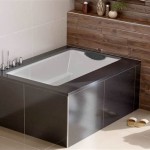What Is a Standard Bathtub Depth?
A standard bathtub depth is a key factor to consider when planning a bathroom renovation or selecting new fixtures. It directly influences the bathing experience, comfort, and overall functionality of the bathtub. While there is no single, universally accepted standard, industry guidelines and common practices offer insights into typical depths found in residential bathtubs.
Understanding Bathtub Depth
Bathtub depth refers to the vertical distance between the bottom of the tub and the overflow drain, the point where excess water spills out. This measurement is crucial because it determines the amount of water the tub can hold and the level of immersion a bather can achieve. A deeper tub allows for a more complete immersion, while a shallower tub might be better suited for quick showers or individuals with mobility limitations.
The depth of a bathtub can vary depending on the specific model, style, and manufacturer. However, there are general guidelines and common ranges that apply to most residential bathtubs.
Standard Bathtub Depth Ranges
In the United States, a typical standard bathtub depth for a standard-sized tub ranges from 14 to 16 inches. This depth is generally considered sufficient for comfortable bathing for most adults. However, it's important to note that these are just guidelines, and individual preferences and physical limitations may vary.
Here's a breakdown of common bathtub depths and their respective uses:
- 14-16 inches: This range is the most common for standard bathtubs and generally offers a comfortable immersion for adults.
- 18-20 inches: Deeper tubs, often found in luxury bathrooms or soaking tubs, provide a more immersive bathing experience and are well-suited for taller individuals or those who prefer a deeper soak.
- Less than 14 inches: Shallower tubs, sometimes found in smaller bathrooms or those designed for accessibility, may limit the water level and offer a less immersive experience.
Factors Affecting Bathtub Depth
Several factors can influence the overall bathing experience and the perceived depth of a bathtub. These include:
- Tub Shape: The shape of the tub, particularly its bottom and sides, can affect how much water it holds and the overall sense of depth. A rounded bottom will tend to feel shallower than a flat bottom, even with the same depth measurement.
- Tub Material: Different materials, such as acrylic, fiberglass, or cast iron, can impact the perception of depth. Some materials, like cast iron, tend to feel more substantial and deeper than others.
- Personal Preference: Ultimately, the ideal bathtub depth is a matter of personal preference. Individuals who enjoy a deep, immersive soak will favor deeper tubs, while others may prefer a more shallow experience for ease of entry and exit.
When choosing a bathtub, measuring the depth with a tape measure is always advisable. It's also helpful to consider your individual needs, preferences, and the overall design of the bathroom before making a final decision.

Standard Bathtub Sizes By Type To Help You Choose The Perfect Tub

Standard Bathtub Sizes By Type To Help You Choose The Perfect Tub

How To Choose Bathtub Sizes

Freestanding Bathtub Dimensions A Sizing Guide With Faqs

What Is The Soaking Depth In A Bathtub And How To Choose Giving Tree

What Is The Standard Size Of A Bathtub

Best 25 Standard Tub Size Ideas

Universal Tubs Hd Series 60 In Left Drain Step Walk Soaking Bath Tub With Low Entry Threshold White Hdsi3060lws

Are Bathtub Sizes The Rough In Size Or Tub Interior Home Improvement Stack Exchange

Standard Bath Size Length Width Dimensions
Related Posts








